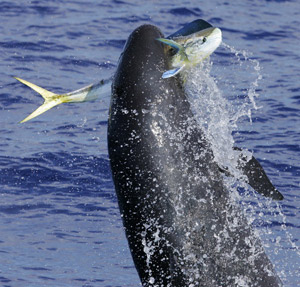 |
Scientific Name: Pseudorca crassidens
Category: Cetaceans

False killer whale with mahimahi. Photo © Dan McSweeney. |
The False Killer Whale is a member of the dolphin family. Their skull is similar to the skull of the Killer Whale (Orca), although they do not look physically like each other. Much of what is known about this species comes from beached whales, animals in captivity, and studies of whale populations near islands in the world's oceans. As they are at the top of the food web, they are naturally rare and populations are small. There are no known predators of the False Killer Whale. They have not been well studied, so the total population world-wide is not yet known.
The False Killer Whale is black to dark grey in color with a light patch or "blaze" from their chin to belly. They have a long, slender body and males have a rounded or melon shaped head that is more noticeable than in females. Their blunt snout overhangs their lower jaw, giving them a distinct overbite. Their dorsal fin is tall and is shaped like a wave. Their flippers have a bulge near the front edge of the fin that is often referred to as an elbow.
Males generally range from 3.7-6.1m (12-20 feet) in length and females are from 3.5-5m (11.5-16.5 feet). Adults weigh between 900-1800kg (1-2 tons). Males may live 57 years and females 62 years. Female False Killer Whales generally reach adulthood at 8-14 years of ages and males in their late teens. They breed year round and females are pregnant for 15 months. Each female produces only one calf and will not have another offspring for about 7 years. At birth, the calf is about two meters in length and will nurse for 18-24 months before it is weaned. They are found in tropical and warm temperate waters of all oceans, but also have been sighted in colder waters off Alaska. False Killer Whales like the open ocean, but can also be seen around oceanic islands like Hawaii.
False Killer Whales form strong social bonds amongst themselves and they also swim with other dolphin species, especially Bottlenose Dolphins. They even sometimes mate and breed with bottlenose dolphins in captivity. Groups of 20-100 members swim through the ocean together. They feed both day and night, typically eating up to 5% of their body weight each day. False Killer Whales eat salmon, squid, yellow fin tuna, mahi-mahi, and perch. They have even been seen to attack sperm whales.
False Killer Whales are often identified by their distinct behavior. They follow ships and leap and plunge over the ship's wakes. This is known as porpoising. False Killer Whales like fast-moving ships with bigger wakes. They also play with their food! Once they catch their prey, they shake them around a good deal and then use their teeth to skin the prey and eat the remains. They often share their prey with each other and sometimes with humans.
False Killer Whales use sound to locate food, communicate, and navigate through the ocean. This navigation ability is called echolocation. The sounds they make are whistles, squeaks, and clicks. The whales sometimes strand themselves or "beach" in numbers as high as several hundred. Scientists are not sure why this happens, but it could be individuals following a sick companion into the beach, or when whales are following their prey too far into shallower waters, where the whales get stuck and can not get back to open water.
Large fishing nets and the longline fishing fleet often snare False Killer Whales, so they become part of the bycatch (particularly in waters around Hawaii). The whales also take the fish caught on these lines. This species has also been known to swallow plastic and other ocean debris. Occasionally, fishermen will kill large numbers of the whales to keep them from taking their catch.
Humans are not typically a threat to this species, as the whales are commercially hunted on a small scale only in Japan, Indonesia, and the West Indies. Aerial surveys from 1990s and early 2000s showed a steep decline in populations near the Hawaiian Islands. In 2008, scientists began to tag and track False Killer Whales for the first time. The ICUN (International Union for Conservation of Nature) Redlist currently classifies them as "data deficient, saying global trend or abundance data for this species are unavailable." However, lawsuits against the National Marine Fishery Service to change their conservation status in Hawaii, filed by conservation groups, are still pending.
Research Links Related to False Killer Whale:
|
 |





